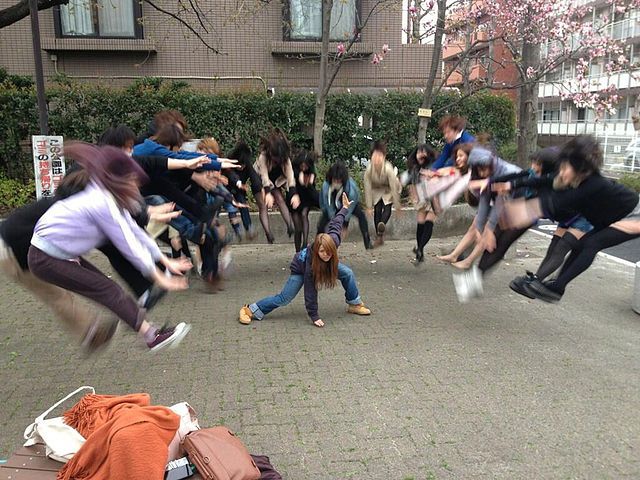
[dt_button link=”http://d165vjqq8ey7jy.cloudfront.net/mp3/27054/se-8255s.mp3″ target_blank=”true” button_alignment=”default” animation=”fadeIn” size=”small” style=”default” bg_color_style=”custom” bg_color=”#333333″ bg_hover_color_style=”custom” bg_hover_color=”#444444″ text_color_style=”custom” text_color=”#ffffff” text_hover_color_style=”custom” text_hover_color=”#dddddd” icon=”fa fa-cloud-download” icon_align=”left”]Yuklash[/dt_button]
[dt_divider style=”thin” /]
Internet Memes Sharing Cultural Ideas
Voice 1
Welcome to Spotlight. I’m Liz Waid.
Voice 2
And I’m Ryan Geertsma. Spotlight uses a special English method of broadcasting. It is easier for people to understand, no matter where in the world they live.
Voice 1
A group of young women walk through a public area in Japan. Suddenly, they stop and gather in a circle. One woman stands in the middle. Another woman walks away from the group. She turns and holds up a camera. The group counts to three in Japanese. The women in the circle jump! They put their legs and arms out in front of them. But the woman in the middle does not jump. Instead, she closes her hand into a fist. She puts her fist on the ground. She acts like she is shouting at the camera. Her friend takes a picture.
Voice 2
This is a strange event to see. But it is becoming more common – in Japan and around the world. This picture is part of an Internet meme. The women will put this picture on the Internet to share with their friends. For many people, this picture will express power, fun and knowledge about electronic video games. Today’s Spotlight is on Internet memes.
Voice 1
A meme is a cultural idea or behaviour. Richard Dawkins is a writer and scientist. In the 1970s, he first used the word meme. Dawkins believes that people communicate cultural information, or memes, in many ways – through books, speeches, signs, works of art and more. Cultural ideas are spread when people copy or tell others about a meme.
Voice 2
For years, most people did not know the meaning of the word meme. But today, more and more people are talking about memes – particularly Internet memes. An Internet meme is a cultural idea spread over the Internet. There are many different forms of Internet memes. Memes can be words, images, songs or even short films. Internet memes can spread quickly. In less than a minute, someone can share a meme with hundreds of people. They can e-mail it or share it on social media websites like Facebook, YouTube or Twitter.
Voice 1
The picture of the young women from the beginning of this program is a popular, global meme. It is called “Makankosappo”. This meme comes from an electronic video game series. Characters in this series use superpowers to fight each other. One of these powers is called makankosappo. Makankosappo makes people fly through the air – away from the person using it. Japanese young people began taking makankosappo pictures. The pictures look like a person is using the makankosappo power! This meme became very popular. And these pictures communicate a lot of information about Japanese culture and video games.
Voice 2
Many internet memes use humor to communicate ideas. In the United States, there is a popular Internet meme called “Grumpy Cat.” This meme is very simple. Each one is a picture of a cat with words. In the picture, the cat looks very angry – even though it is not! People use the pictures of Grumpy Cat and add their own words. The words on the pictures communicate what the cat is supposed to be thinking. These words say things like “I had fun once. It was terrible.” These memes simply make people laugh.
Voice 1
But people also use memes to discuss major, current events. In February 2013, there was a meteor shower in Eastern Russia. A large rock entered into the earth’s atmosphere from space. It broke into many pieces and fell from the sky. It was a frightening event for many people. It was also very unusual. Many Russians created memes about the meteor. One meme made a joke about the event. It was a picture that showed the weather for Eastern Russia. In this image, there was no sun or clouds. Instead, there was a huge meteor! Memes like this helped Russians think about the meteor event. Instead of being afraid of the event, they could laugh at it. And they could recognize the rare and important event.
Voice 2
Memes can also communicate the political culture of a place. In France, there was a famous political meme. It began in 2009, when former President Sarkozy was in power. At this time, Sarkozy was not very popular. And he wanted to change the way people thought about him. So on the anniversary of the ‘Fall of the Berlin Wall’, Sarkozy released a picture of himself on Facebook. The ‘Fall of the Berlin Wall’ was a major event in European history. The picture showed Sarkozy in a crowd standing by the wall. Sarkozy wrote a comment about being present when the Berlin Wall fell. He hoped that this picture might help make him more popular.
Voice 1
However, people began to question if the picture was real. News writers reported that Sarkozy could not have been in Berlin on the day the wall fell. It was clear that the picture must have been taken days later. When people recognized that Sarkozy’s claim was false, they were angry. They did not like the idea that their government would try to fool them. So they began to create their own pictures. They used computer programs to add Sarkozy to pictures of other important events – events he was not at. These pictures became a very popular meme called “Sarkozy Was There”. This meme was a joke. But it was also a way for the French people to express their lack of trust for the President.
Voice 2
Internet memes can spread cultural information faster, and to more people, than ever before. However, this is not always a good thing. When a person becomes part of a popular meme, it can be very difficult for them.
Voice 1
In Canada, a young man named Ghyslain Raza recorded a short film of himself. In this video, he acted like a character from the Star Wars films. Raza did not want to share the video. But students from his school found the video. And they put it on the internet. This “Star Wars Kid” video became very popular. Soon, people began making changes to the video. Other people made their own versions of the “Star Wars Kid” video. The meme became very popular.
Voice 2
But life for Raza became very difficult. On the Internet, people he did not know were making jokes about him. At school, people laughed at him. And Raza had no way to stop it. He became very sad. Things got so bad that Raza left school. And he received medical treatment for depression.
Voice 1
Internet memes can spread cultural information quickly and powerfully. But have you ever thought about the effects of sharing internet memes? What memes are popular in your country? Do you think these memes are positive or negative? Leave your comments on our website! Or you can email us at radio@radioenglish.net.
Voice 2
The writer and producer of this program was Dianna Anderson. The voices you heard were from the United States. You can listen to this program again and read it on the internet at www.radioenglish.net. This program is called “Internet Memes: Sharing Cultural Ideas.”
Voice 1
We hope you can join us again for the next Spotlight program. Goodbye!




Rasm chotki chiqibdi